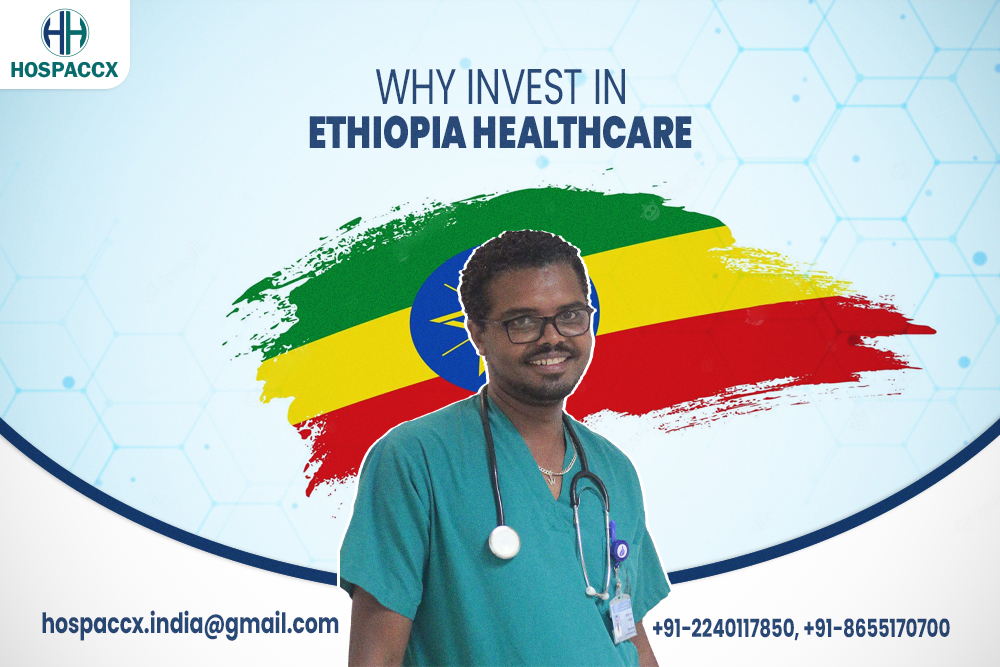WHY INVEST IN ETHIOPIA HEALTHCARE
Are you aware of healthcare market scenario of Ethiopia? Are you planning to invest in healthcare of Ethiopia? Hospaccx healthcare business consultancy has mapped all the information related to healthcare scenario of Ethiopia.
If you need a refined market and financial feasibility or any other study related to healthcare is required you can contact Hospaccx Healthcare business consulting Pvt. ltd on Hospaccx.India@gmail.com or you can visit our website on https://hospaccxconsulting.com/
INTRODUCTION
The Government of Ethiopia is working to strengthen the healthcare system to align it with the Millennium Development Goals and it has made significant investments in the public health sector which have led to improvements in the health outcomes. Nevertheless, communicable diseases like HIV/AIDS, TB, malaria, respiratory infection, and diarrhea remain a serious challenge in Ethiopia. High fertility rates and low contraceptive prevalence continue to drive a rapidly increasing population in Ethiopia. With a growing middle class, the GOE is facing an increase in non-infectious diseases such as cancer, diabetes, heart diseases, hepatitis B&C and high blood pressure.
STATISTICS OF ETHIOPIA
| Total population (2016) | 102,403,000 |
| GNI per capita (PPP international) | 1,350 |
| Life expectancy at birth m/f (2016) | 65/67 |
| Probability of dying under five (per 1000 live births (2018) | 55
|
| Literacy | 49% of total population |
HEALTHCARE INFRASTRUCTURE
The Ethiopian Food, Medicine and Health Care Administration and Control Authority has reported that there are currently more than 16,600 healthcare centers deliver health services in Ethiopia. The government encourages private sector participation in the area of quality of care and quality of service.
The government is also working with the private sector to build advanced tertiary care hospitals to meet domestic demand that would otherwise be met through outbound medical tourism, and ultimately to attract medical tourism to Ethiopia. The Ethio-American Hospital, which began construction in April 2017 and plans to begin operations by December 2019, is an example of the government’s commitment to developing major new healthcare facilities. This project also demonstrates the government’s commitment to encouraging foreign investment in the sector through public private partnership (PPP) arrangements.
CHALLENGES IN THE HEALTHCARE SECTOR IN ETHIOPIA
- Lack of transparent and accountable pharmaceutical and logistics management system.
- Shortage of foreign currency hindering timely procurement of equipment, supplies and pharmaceuticals. Foreign exchange shortages also result in payment delays.
- Delays in the bidding process.
- Poor data management and reporting for proper decision making.
- Lack of capacity.
TOTAL NUMBER OF HEALTH FACILITIES
| Facility level | Public | Private | Subtotal |
| Hospitals (including specialty, referral, general) | 302 | 62 | 364 |
| Specialty centers/ specialty clinics | 0 | 867 | 867 |
| Health centres/ Medium clinics | 3,724 | 1,308 | 5,032 |
| Health posts/ Primary and lower clinics | 17,187 | 5,401 | 22,588 |
| subtotal | 20,598 | 7,638 | 28,236 |
For more than 28,000 health facilities in Ethiopia, the public sector owns a majority (73%) while the private sector – both PNFP and PFP – owns / manages 27%. The private health sector infrastructure is concentrated in specialty centers and clinics (100%) with important portion of hospitals (17%) and health centers and health posts 26% and 24% respectively.
Ethiopia has a clear vision for development, which builds off of its rapid growth in recent years and its strong track record in attracting FDI.
Rapid economic growth:
- One of the fastest growing economies in the world – 11% average growth over the past 13 years.
Favorable destination for FDI:
- One of the top destinations for foreign direct investment (FDI)– Ethiopia accounts for 18.5% of all jobs created through FDI in Africa.
Young and productive population:
- Second most populous country in Africa– >100 million people, growing at 2.3 million annually
- Young and productive age group accounts for 60% of the population
Clear vision for development:
- Vision 2025: become leading manufacturing hub in Africa
- Foreign investment is key focus of Prime Minister
- Wide-ranging incentives in priority sectors
Ethiopia can be a hub for Africa, which is a frontier pharmaceutical market valued at >$25B and where high growth is still achievable.
The Ethiopian pharmaceutical market is expected to grow at 15% per year to reach nearly $1 billion by 2020.
Upcoming priorities in the health care sector:
- Implement the use of drone technology for the delivery of vaccines, blood and other health related commodities in the rural areas.
- Improve the management of human and infrastructural resources.
- Improve resource mobilization.
- Improve research and evidence-based decisions and enhance the use of technology and innovation by supplementing with the deployment of appropriate information systems. The MOH has developed a national “Information Revolution Roadmap” that contains actionable and measurable interventions. The Ministry aims to focus on enhancing data usage to positively impact the healthcare sector by maximizing availability and accessibility of high-quality data at all levels in the healthcare system.
- Facilitate the procurement of drugs, supplies and equipment and create availability of essential drugs at the health centers.
- Increase patient satisfaction and address good governance
- Work on an early warning system, risk assessment and multi-sectorial coordination mechanisms that can improve response time for epidemics.
- Procurement of medical equipment from quality providing companies and considering after sales maintenance service as part of contract package.
Total Health Expenditure by Health Area:
A significant share (49%) of Ethiopia’s (THE) Total Health Expenditure was allocated to infectious and parasitic diseases – in line with the country’s disease burden. Of this, nearly 20% was spent on infectious and parasitic disease, 10 percent on HIV/AIDS and other sexually transmitted diseases (STDs), 9% on malaria, 7% on vaccines and 2% on tuberculosis. Nutritional accounted for 13% and 9% on reproductive health services including 4% on family planning, 3% on maternal and prenatal conditions and 2% on other reproductive health conditions.
Summary of Demand and Supply Drivers of the Health Care Sector, and of Constraints:
Demand Drivers:
- Rising household incomes
- Growth in literacy / education
- Urbanization
- Increased affordability due to spread of provider payment schemes and insurance mechanisms
- Growing confidence of people in the quality of providers through experience
- Improved access to specialized skills/technology because of infrastructure (roads etc.) development.
Supply Drivers:
- Increased public sector health spending
- Subsidized medical and paramedical education supplying steady stream of professionals in the market
- Freedom for recruitment of professionals, including of government professionals for part-time work in private facilities
- Low barriers to private sector entry into health care services
- Favorable rules and regulations for private sector investment, including facilitated access to funds for investment
- Tax exemptions for medical equipment
Constraints:
- Shortage and uneven distribution of medical facilities
- Shortage, uneven distribution, and high turnover of trained professionals, particularly in specialty areas
- Limited availability and rising cost of quality pharmaceutical supplies
- Inadequate payments and financial mechanisms
- Seasonal fluctuations of patient flow
- Maintenance of bio-medical equipment
Currently the below list of health care facilities available in Ethiopia:
- Health Posts: 17,154 available and 438 under construction
- Health Centers: 4,063 available and 68 under construction
- Hospitals: 338 available and 218 under construction
- Private Clinics: 3867
- Private Hospitals: 43
OPPORTUNITIES:
- The GOE is keen to acquire service, equipment, supplies, and information management systems.
- Knowledge and skill transfers to improve the quality of the healthcare system. This is an opportunity for the companies that are providing equipment and supplies, hospital furniture.
- Ambulances for emergency, pharmaceuticals, vaccinations and other services.
CONCLUSION:
Long-term investment in Ethiopia’s health care system will focus on increasing the number of health facilities available (which includes hospitals, clinics, laboratories and diagnostic centers in both the rural and urban areas and establishing adequate training institutions for health professionals to meet the mass shortage of doctors, nurses, and other professionals.
It is the superficial and macro level study for more details kindly contact Hospaccx Healthcare business consulting Pvt. ltd on Hospaccx.India@gmail.com or you can visit our website at https://hospaccxconsulting.com/
Related Team Members










